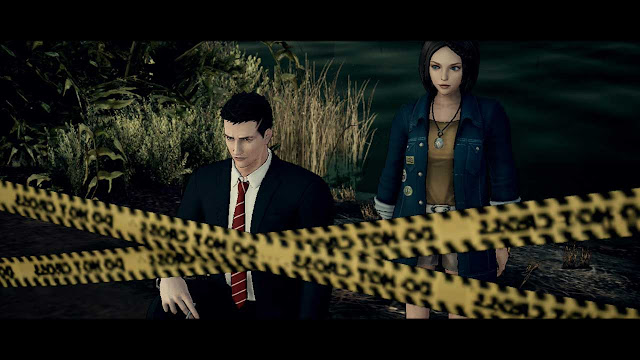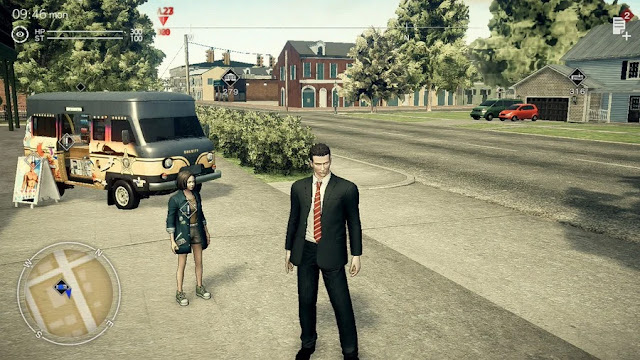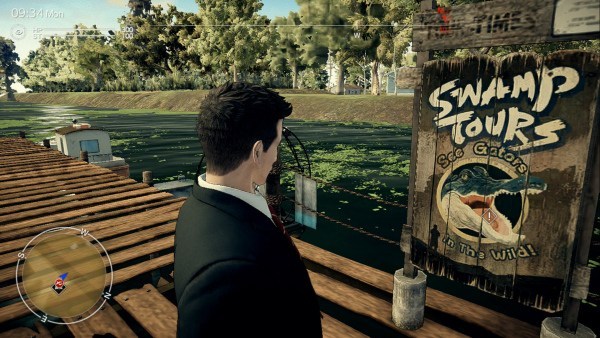Review by Matt S
Deadly Premonition was released ten years ago now, and you’d think that in that time people would have learned. But, nope. Ten years ago people fixated on technical issues of that game at the expense of the greater point, only for Deadly Premonition to eventually become celebrated because the greater point is, in fact, more important. Now they’re pulling the same stunt with Deadly Premonition 2. Who cares if the frame rate is inconsistent? You can finish the game, and so it gets the job done. Case closed there. What’s actually important here is that the game is a brilliant bit of comedy/horror/noirish surrealism, and it is the most distinctive, original, creative thing you’ll play this year.
In fact, given that Deadly Premonition 2 seems to be everything that Deadly Premonition 1 was, dialled up to 11, I’m reasonably confident that the writer/creative behind it, SWERY, deliberately make the game this way, knowing full well how it would be received, in a transgressive moment of “I just don’t give a bleep.” I really wouldn’t put it past him. SWERY has produced highly refined, technically precise games in the interim between Deadly Premonition and its sequel. For the sequel to turn out like this does very much feel like a challenge to weed out the critics who are going to look at this thing as a creative pursuit rather than those that look at games as entertainment products.
Deadly Premonition 2 kicks off with an older (and very sick) Francis York being interrogated by a couple of younger detectives over an old case that he participated in, as new evidence has come to light that has cast a shadow over him personally. Through their eyes, York is presented as something truly malign – a dark and overwhelmingly competent intelligence that is hiding any number of secrets behind a façade of eccentricities. What’s more is that he’s under the influence with a particular substance, and combined, this 30-minute introductory sequence acts as a spot-on framing device. Deadly Premonition 2 makes clear what Deadly Premonition 1 hints at – Francis York is not a reliable narrator, and therefore, once the flashback happens and York starts telling his story, we’re given a dual mystery to solve; the murder itself, and the challenge of separating reality from York’s fictions.
These mysteries play out in a tiny little backwater town in Louisiana, some ways out from New Orleans. It’s blisteringly hot, laid-back and most of the people are ostensibly friendly… but that’s just on the surface. Deadly Premonition 2 plays more explicitly in the noir tradition than the original did, replacing some of the overt horror themes with that other side of Twin Peaks (as in the David Lynch TV show that provided much of the inspiration for the narrative). You’re looking into a seedy, often sinister underbelly in Deadly Premonition 2, and most people – York himself included – are morally compromised, while the good and innocent inevitably find themselves eaten completely by the shadows.
Now, noir isn’t usually melded with surrealist humour, and for a pretty good reason, really. There’s a point where humour – so often associated with surrealism – can become so dark that it becomes a particularly heavy kind of uncomfortable. Deadly Premonition 2 certainly hits those notes; in depicting a hyper-exaggerated “quaint deep south”, built entirely of the clichés of York’s “memory,” Deadly Premonition 2 steps on toes. I’ve seen plenty of comments regarding racism and transphobia already, and I’m not going to deny the validity of those observations. People are going to feel and interpret based on what they see, and such observations are always valid. It’s also worth noting that the entire surrealism movement has been frequently associated with insensitivities, so these observations are not without plenty of historical precedents. With that being said, the noir genre, dour as it tends to be, is one critical of society, and I certainly don’t think Deadly Premonition 2’s York is meant to be a sympathetic protagonist, any more than Raymond Chandler’s Marlowe character is. My read on the game is that the surrealistic humour and eccentricities are in service of the noir, and to me, the game does come across as particularly dense and inaccessible in its themes, but overall it’s a social critique.
It is hard to feel that at times though because so much of the game is in service of humour, and Deadly Premonition 2 is frequently, deeply funny. SWERY is very similar to Yoko Taro, in that his sense of humour is self-aware and self-deprecating. Yoko Taro throws philosophy into NieR: Automata, as often to mock the thought of philosophy as to explore it (that flows through to him as a person too – when I had the opportunity to interview Yoko Taro he delighted in explaining to me how he does all his reading on philosophy while sitting on the toilet). SWERY does a similar thing, but with artistic tradition. For just one example, York loves musing to himself on film. He does it a lot. In just one instance by way of example he describes Michael Bay’s The Island in terms so overwrought flattering terms that it reads just like that infamous “The Last Of US 2 is the Schindler’s List” tweet… and I know this game would have been written before that tweet, but I love the thought of SWERY just throwing that in as a subtle ribbing via a last-minute patch. The point is, though, that SWERY is well aware of just how pretentious all this art talk can become, and while his game is assuredly an entry into that particular discourse, it doesn’t believe it is above being joked about, either.
Elsewhere, York has the ability to embark on minutes-long philosophical deconstructions of the most mundane things, moments before shifting to something completely different, such as a deadpan conversation with a voodoo spirit speaking to him through paintings. Every scene in Deadly Premonition 2 is framed in the most poetically ridiculous description and “Yorkian” analysis, followed by other scenes and conversations that don’t have any meaningful associations between them – this is a surrealist trick that we’ve seen as far back as Antonin Artaud and his A Jet of Blood play. There is a narrative to follow, and it’s linear and cohesive, but the game does love getting there through a patchwork of seeming randomness. None of this is easy to actually write, and I was concerned early on over whether SWERY could maintain the pacing and tone of the first few hours, but as it turns out he actually does. This game must have been a delight to localise because there isn’t a beat where your first response won’t be “no one would talk, behave, or think like that” followed by laughter at the way that the game is parodying the very concept of characterisation and narrative flow.
It’s fair to say that the gameplay of Deadly Premonition 2 is built around the delivery of its characters and wickedly surreal sense of humour, and as I mentioned above, it actually comes across as a subversive rejection of everyone that fixated on this side of things in the original. To be blunt: it doesn’t play well. But it’s also deeply funny because it doesn’t play well, and that’s the point. The frame rate collapsing at random moments comes across more like a Dali painting breaking the rules to deliver a wild surrealist vision rather than a beginner’s art class’ floundering efforts to recreate the Mona Lisa. There’s real meta-humour in the clunky combat, given what you’re fighting and the tools that you’re using to do it. The tiny little open world that you explore, and the time-based quest structure which frequently delivers extended “dead times” where you’re left without much to do, is really just a bit of ribbing at how shallow and empty the entire open world “genre” is in bigger games, when you strip away the superficial efforts to throw endless engagement at players. Deadly Premonition 2’s visual aesthetic captures the aesthetic of the most B of B-tier beautifully… and then there are the over-wrought, hyper-slick Tarantino-esque moments thrown in randomly just to poke a bit of fun at the idea of “slick production values.”
None of this will be for everyone; by their very nature subversion and surrealism are movements that, in resisting the mainstream are not for the mainstream. This isn’t a case of being “so bad it’s good”. That’s a nonsense phrase that in most cases people use to describe subversion as though it’s an accident – the idea that subversives haven’t made something “good” relies on the analysis of their work in comparison to the stuff that they are actively rejecting. Which is a nonsense way of looking at their work, when you think about it. Edward Wood was “so bad it’s good” in that he set out to make mainstream quality films, failed, and now we can all have a bit of fun watching them. Tommy Wiseau with The Room is much the same. SWERY, like Dali, Artaud and the other surrealists, didn’t set out to make a game to meet the same expectations of the popular and big-budget things in their respective mediums. Instead, surrealists set out to deconstruct and satirise that very notion, and while the result isn’t for anyone, by any means, these things can be very good at what they aim to achieve. To criticise SWERY’s game here against something like The Last of Us 2 is, by definition, to misunderstand it.
I’ve seen some people describe Deadly Premonition 2 as the “anti-The Last Of Us 2”. While that’s a comparison of convenience more than anything because they’ve been released so close to one another, it’s actually apt because they do sit at the extreme opposite ends of a spectrum. The Last of Us 2 epitomises everything about overly-produced, mass market-friendly content that many of us are becoming exhausted with. SWERY, knowing full well that his game will be castigated on Metacritic and widely mocked, has satirised every mainstream expectation of a video game in Deadly Premonition 2. There’s nothing that suggests that anything within this game is not an entirely deliberate, surrealistic subversion of expectations, and while Deadly Premonition 2 is not for everyone (and potentially offensive to some), games as an art form are better off having works like this to exist in parallel to mainstream entertainment.
– Matt S.
Editor-in-Chief
Find me on Twitter: @mattsainsb
The critic was provided with a copy of the game for the purposes of review











